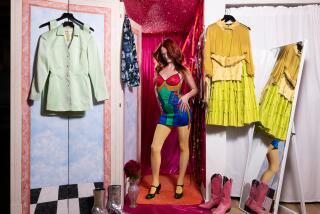HIPSTER’S HISTORY : A New! Improved! Account of British Design
- Share via
British designers did a few noteworthy things back in the Dark Ages--you know, the 1700s, the 1800s, all those boring years at the beginning of this century. But they really got with it in the 1970s, when punk culture had its 15 minutes of fame, and they are kings of attitude today.
This New! Improved! account of British design comes to you via “British Design 1790-1990,” an exhibit at South Coast Plaza’s Jewel Court of objects lent by the Victoria and Albert Museum in London and by the studios of contemporary designers. So long as you don’t mistake the display for a serious history lesson, it has quite a few goodies to offer.
The emphasis on design begins with Din Associates’ installation of the furniture, tableware, clothing and other objects, which are lovingly lit and “window dressed” in plexiglass cases cantilevered over the sides of smart wooden stanchions. While the real V&A; is a musty, dusty place where you can wander in dimly lit privacy, the South Coast Plaza version is as spiffy as a Tiffany window.
The object-lesson begins with Wedgwood, the pottery giant that helped move British crafts out of the cottage industry days and into the Industrial Revolution--with the innovations of steam power, the division of labor, research and development methods and even the bold step of newspaper advertisements.
Artists and writers of the 18th-Century Neoclassical period looked to ancient Greece and Rome for inspiration. As shown in the Wedgwood product, the applied style emphasized elegant linear design, such as the starkly angular silhouette of a late 18th-Century teapot made of black basalt, or the arching, ribbonlike handles on a creamware cruet set from 1820. But design standards sagged into the unfunctional clutter and fussiness that will forever be associated with the Victorian age. The Great Exhibition of 1851--a trade fair organized to push good home-grown design--financed the founding of the South Kensington Museum (as the V&A; was originally known) for the display of well-made items. Still, goods from the period--such as a chair with a painting of young Queen Victoria trapped within carved wooden curlicues--remain amusingly hideous conversation pieces.
William Morris’ was the first loud voice raised against the creeping ugliness ushered in by the Industrial Age, although the exhibit also properly credits such individuals as A.W. Pugin, the champion of spiky Gothic design, and Christopher Dresser.
Morris and Co. was dedicated to reviving sturdy vernacular styles and emphasizing the value of handwork. One of the company’s products was a chair with a rush seat, slim, high-set arms and a graceful back made of curved strips of wood.
Morris’ Arts and Crafts Movement was broadly influential in Britain. One of the most striking pieces of furniture in the show is a boldly geometric ladder-back chair from 1916 by Charles Rennie Macintosh, a Scot who put Glasgow on the map as a design center.
Exhibit curator Catherine McDermott admits that design standards “didn’t do so great in the 1920s and ‘30s,” decades represented in the show by such items as silly souvenir mugs and an unintentionally goofy-looking earthenware sculpture of bare-breasted huntress Diana, whose hair looks like it was done by a predecessor of Vidal Sassoon.
So we race onward to the ‘90s--about half the material in the show comes from the past couple of years--and watch style and workmanship become a rude joke. Anyone who has lingered wistfully at the V&A;’s superlative collection of designer clothes from eras past must feel some irritation at the sight of a tiny, sequin-spangled denim jacket and skirt by top designer Katharine Hamnett.
Many of the recent pieces in the show are riotously heavy on whimsy but short on charm, elegance or even practicality. Ah well, it seems the V&A; has leaned over backward to be appealing to us unwashed, glitz-happy Californians. This is the Cliff’s Notes hipster version of design history--a casual shopper’s delight.
More to Read
The biggest entertainment stories
Get our big stories about Hollywood, film, television, music, arts, culture and more right in your inbox as soon as they publish.
You may occasionally receive promotional content from the Los Angeles Times.










